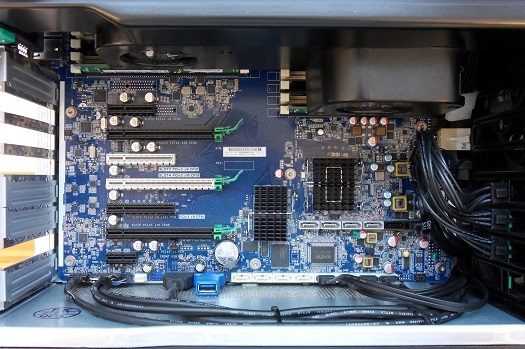
Viz Engine
Version 3.10 | Published April 03, 2018 ©
HP Z840
This section describes how to setup a HP Z840 machine with the different cards provided by Vizrt. The HP Z840 (5U rack units) is a high performance workstation that can be configured with two CPUs, has 16 memory slots, multiple storage and PCIe configuration options.
More details about the HP Z840 can be found on HP’s website: HP Z840 Info and HP Z840 Support.

IMPORTANT! Before touching any components make sure you use an anti-static wrist strap to prevent electrostatic discharge.

HP Z840 PCI/PCIe Slot layout and usage
Single GPU setups (one graphics device):
|
Slot # |
Type |
Used for |
|
16 |
PCIe3 x4 - CPU0 |
AES Audio card (if required/used) |
|
17 |
PCIe3 x16 - CPU0 |
Graphics card 1 |
|
18 |
PCIe3 x8 - CPU1 |
free |
|
19 |
PCIe3 x16 - CPU1 |
free |
|
20 |
PCIe3 x8 CPU1 |
free |
|
21 |
PCIe3 x16 - CPU0 |
Video card (Matrox, DVS or Bluefish) |
|
22 |
PCIe2 x1 - PCH |
Radial Aerator (if needed, see note below) |
Dual GPU setups (two graphics devices):
|
Slot # |
Type |
Used for |
|
16 |
PCIe3 x4 - CPU0 |
AES Audio card (if required/used) |
|
17 |
PCIe3 x16 - CPU0 |
Graphics card 1 |
|
18 |
PCIe3 x8 - CPU1 |
free |
|
19 |
PCIe3 x16 - CPU1 |
Video card (Matrox, DVS or Bluefish) |
|
20 |
PCIe3 x8 CPU1 |
free |
|
21 |
PCIe3 x16 - CPU0 |
Graphics card 2 |
|
22 |
PCIe2 x1 - PCH |
free |
IMPORTANT! A Radial Aerator is recommended for the Matrox X.mio2 video boards. However, the Radial Aerator is not needed for video cards with an onboard fan, such as the Matrox X.mio3, DVS Atomix or Bluefish Epoch 4K Supernova. The Radial Aerator cannot physically be installed with the Xmio.2 Plus board, in which case the BIOS chassis fan speed setting must be set to maximum to achieve sufficient cooling.
Z840 BIOS Settings
-
Advanced – Power Options – Fan Idle Mode
-
With one Graphic card: two steps below maximum: **
-
With two Graphic cards: maximum ****
-
-
Advanced – Performance Options:
-
Intel Hyper Threading Technology: Disabled
-
QPI mode: Home Snoop
-
Memory expansion
Memory expansions must follow the predefined fill-order and memory-type requirements. There is a table documenting the memory fill order inside the server cabinet. Use this table as a reference when adding memory modules.